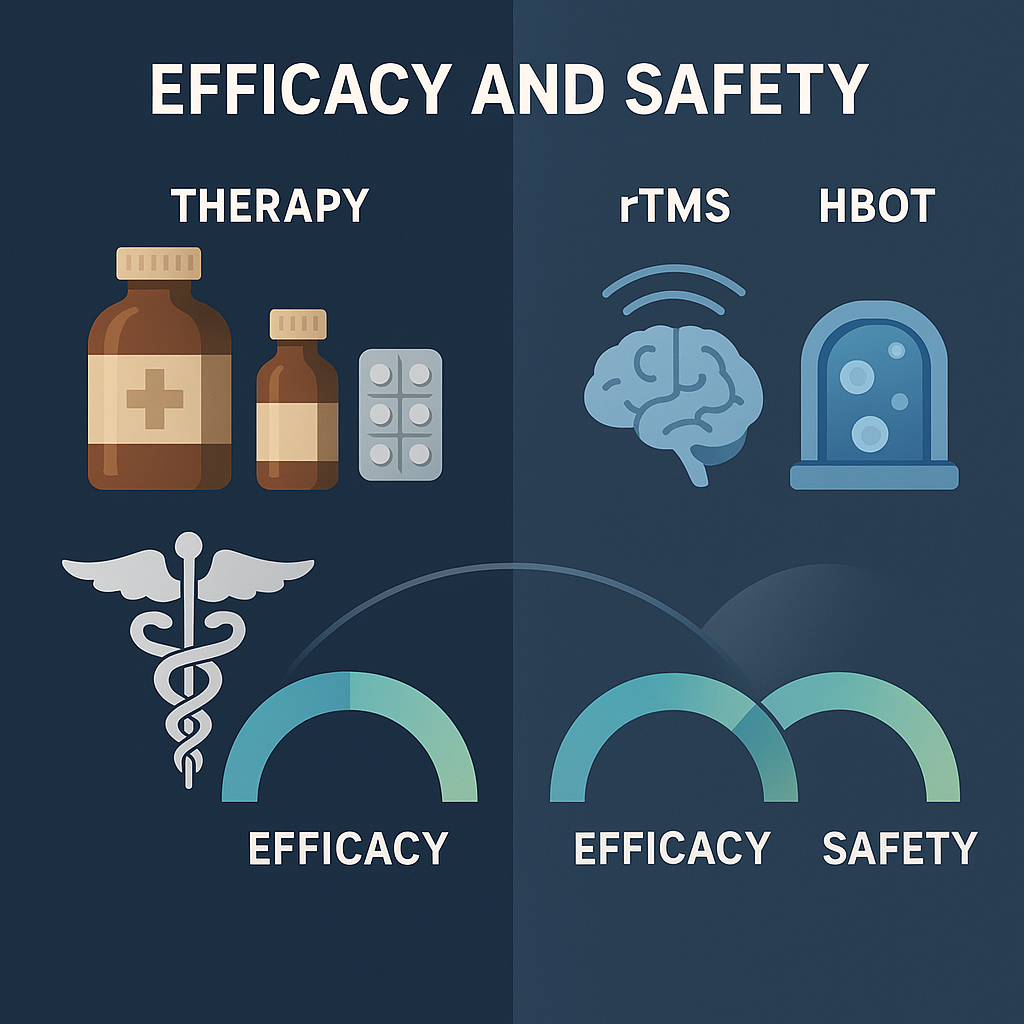Traditional vs. Emerging Modalities: Where rTMS and Hyperbaric Oxygen Fit
Conventional first-line treatments for mood disorders, such as selective serotonin re-uptake inhibitors (SSRIs) and electroconvulsive therapy (ECT), are commonly utilized but come with significant drawbacks like delayed onset and adverse effects. In contrast, repetitive transcranial magnetic stimulation (rTMS) and hyperbaric oxygen therapy (HBOT) present non-invasive alternatives that have shown favorable tolerability profiles Romańczyk et al., Pharmaceuticals 2021.
Efficacy head-to-head
Research comparing rTMS to ECT indicates that rTMS offers moderate and short-term efficacy that rivals both ECT and transcranial direct-current stimulation (tDCS), while avoiding the high relapse rates associated with ECT, which can reach approximately 37% despite continued pharmacotherapy Romańczyk et al.. Furthermore, a meta-analysis involving 27 trials underlined that HBOT, acting as both adjunctive or standalone therapy, significantly decreased Hamilton Depression Rating Scale scores while producing fewer adverse events than standard antidepressant treatments Liang et al., Clin Neurol Neurosurg 2020.
Safety and tolerability
When considering adverse events, rTMS is notable for its limited side effects, primarily transient scalp discomfort and rare seizures. This contrasts sharply with the sexual dysfunction associated with SSRIs and cognitive impairments observed in ECT treatments Romańczyk et al.. On the other hand, the most common side effect of HBOT is middle-ear barotrauma, which is typically mild and infrequent, making it an appealing option for patients who are intolerant to pharmacologic therapies Romańczyk et al..
Accessibility and logistics
rTMS can be conveniently administered in outpatient settings without the need for anesthesia, requiring daily sessions over 4-6 weeks. Conversely, HBOT necessitates a pressurized chamber but its integration in multi-place facilities within rehabilitation units has made it more accessible to patients. Both of these modalities avoid the complications related to hepatic metabolism and drug-drug interactions, which is especially beneficial in populations burdened by polypharmacy Romańczyk et al..
Decision matrix: when to prefer rTMS or HBOT
A strategic approach to choosing between rTMS and HBOT can be summarized as follows:
1. If a patient has medication intolerance or contraindications (such as pregnancy or hepatic disease), either rTMS or HBOT can be considered.
2. For rapid functional recovery without cognitive side effects, HBOT is preferred, particularly for cases like post-stroke depression.
3. In instances where patients have previously not responded to ECT or refuse anesthesia-based therapies, rTMS is indicated.
4. Patients with co-morbid neurological injuries that demonstrate a hypoxic component, such as traumatic brain injuries, may benefit from HBOT due to its neuro-restorative properties Miller et al., JAMA Intern Med 2015.
5. Outpatient adherence should also be considered: rTMS is suitable where daily clinic attendance is feasible, while HBOT can accommodate those needing caregiver-assisted, once-daily blocks.
Limitations to acknowledge
Despite their advantages, both rTMS and HBOT have notable limitations. The durability of rTMS responses often requires follow-up “booster” sessions, while the availability and reimbursement for HBOT chambers can vary significantly across different jurisdictions. There exists a critical gap in robust comparative randomized controlled trials (RCTs) directly comparing these interventions with high-dose SSRIs or maintenance ECT, highlighting the necessity for future pragmatic trials Romańczyk et al..
Toward Next-Generation Neurotherapeutics: Key Takeaways & Future Directions for rTMS and Hyperbaric Oxygen Therapy
The evolution of neurotherapeutic techniques has led to significant insights that target the modulation of cortical excitability, whether through electromagnetic means such as rTMS or through the administration of hyperbaric oxygen. rTMS has transitioned from a research-focused technique to an FDA-approved treatment for major depressive disorders, showcasing response rates similar to those of traditional pharmacotherapy options but without the systemic toxicities Romańczyk et al.. HBOT also displays promising evidence of psychotropic benefits, with a notable meta-analysis reporting significant reductions in depression scores alongside lower adverse event rates when compared to traditional antidepressants Liang et al., Clin Neurol Neurosurg 2020.
Mechanistic convergence
Both rTMS and HBOT engage in complex biological processes that lead to structural and functional neurological benefits. rTMS is known to induce long-term synaptic plasticity within critical areas of the brain, fostering improved stability in mood regulation. HBOT amplifies the availability of oxygen in tissues, which leads to the stimulation of several neuroprotective processes such as neurogenesis, angiogenesis, and remodeling of dendritic spines long after a cerebral injury Efrati et al., PLoS One 2013.
Clinical positioning
Given that both rTMS and HBOT are non-invasive and outpatient-based, they present an appealing option for difficult-to-treat conditions such as treatment-resistant depression and post-concussion affective syndromes. A review of large safety datasets confirms the rarity of serious adverse events associated with either therapy, with risks being exceedingly low Romańczyk et al.; Hadanny & Efrati 2016.
Unmet needs & research agenda
The exploration of rTMS and HBOT as therapeutic options carries with it several avenues for further research. These include:
1. Optimizing the dosage of both rTMS and HBOT to ensure maximum efficacy.
2. Implementing biomarker-guided selection to tailor therapies based on individual patient profiles.
3. Investigating the synergistic potential of sequenced therapies, with preliminary evidence supporting combined applications.
4. Assessing the long-term durability of treatments and establishing frameworks for maintenance sessions.
5. Expanding indications into other mental health disorders like PTSD and OCD, which require larger-scale studies for validation.
6. Conducting health-economic analyses to evaluate the cost-effectiveness of these therapies in reducing hospitalization and medication burdens on patients.
In summary, rTMS and HBOT represent a significant advancement in treatment paradigms, pivoting from mere symptom management to actual repair of dysfunctional neural circuitry. Continued investment in methodologically sound studies will likely define their roles in the future landscape of psychiatric care.
